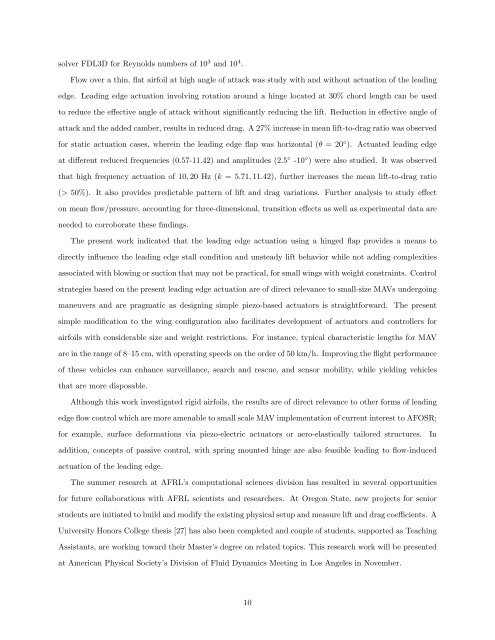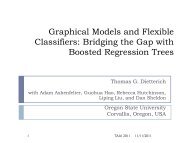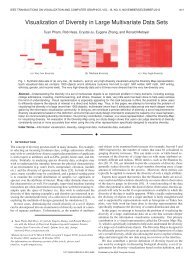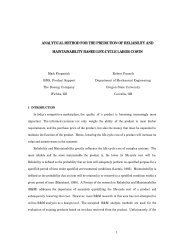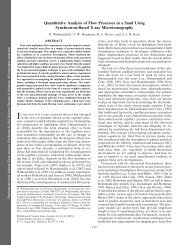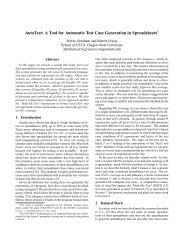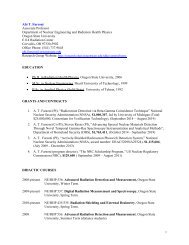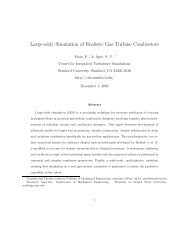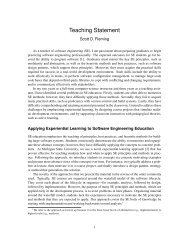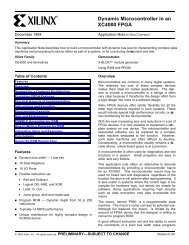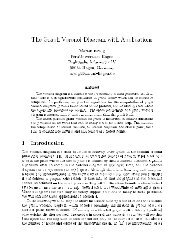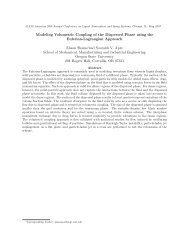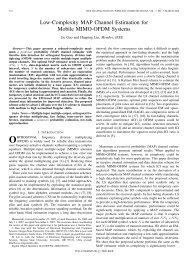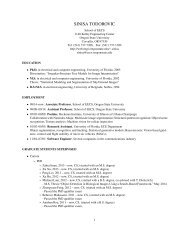DNS of Low Reynolds Number Flow Dynamics of a Thin Airfoil with ...
DNS of Low Reynolds Number Flow Dynamics of a Thin Airfoil with ...
DNS of Low Reynolds Number Flow Dynamics of a Thin Airfoil with ...
- No tags were found...
Create successful ePaper yourself
Turn your PDF publications into a flip-book with our unique Google optimized e-Paper software.
solver FDL3D for <strong>Reynolds</strong> numbers <strong>of</strong> 10 3 and 10 4 .<strong>Flow</strong> over a thin, flat airfoil at high angle <strong>of</strong> attack was study <strong>with</strong> and <strong>with</strong>out actuation <strong>of</strong> the leadingedge. Leading edge actuation involving rotation around a hinge located at 30% chord length can be usedto reduce the effective angle <strong>of</strong> attack <strong>with</strong>out significantly reducing the lift. Reduction in effective angle <strong>of</strong>attack and the added camber, results in reduced drag. A 27% increase in mean lift-to-drag ratio was observedfor static actuation cases, wherein the leading edge flap was horizontal (θ = 20 ◦ ). Actuated leading edgeat different reduced frequencies (0.57-11.42) and amplitudes (2.5 ◦ -10 ◦ ) were also studied. It was observedthat high frequency actuation <strong>of</strong> 10, 20 Hz (k = 5.71, 11.42), further increases the mean lift-to-drag ratio(> 50%). It also provides predictable pattern <strong>of</strong> lift and drag variations. Further analysis to study effecton mean flow/pressure, accounting for three-dimensional, transition effects as well as experimental data areneeded to corroborate these findings.The present work indicated that the leading edge actuation using a hinged flap provides a means todirectly influence the leading edge stall condition and unsteady lift behavior while not adding complexitiesassociated <strong>with</strong> blowing or suction that may not be practical, for small wings <strong>with</strong> weight constraints. Controlstrategies based on the present leading edge actuation are <strong>of</strong> direct relevance to small-size MAVs undergoingmaneuvers and are pragmatic as designing simple piezo-based actuators is straightforward.The presentsimple modification to the wing configuration also facilitates development <strong>of</strong> actuators and controllers forairfoils <strong>with</strong> considerable size and weight restrictions. For instance, typical characteristic lengths for MAVare in the range <strong>of</strong> 8–15 cm, <strong>with</strong> operating speeds on the order <strong>of</strong> 50 km/h. Improving the flight performance<strong>of</strong> these vehicles can enhance surveillance, search and rescue, and sensor mobility, while yielding vehiclesthat are more disposable.Although this work investigated rigid airfoils, the results are <strong>of</strong> direct relevance to other forms <strong>of</strong> leadingedge flow control which are more amenable to small scale MAV implementation <strong>of</strong> current interest to AFOSR;for example, surface deformations via piezo-electric actuators or aero-elastically tailored structures.Inaddition, concepts <strong>of</strong> passive control, <strong>with</strong> spring mounted hinge are also feasible leading to flow-inducedactuation <strong>of</strong> the leading edge.The summer research at AFRL’s computational sciences division has resulted in several opportunitiesfor future collaborations <strong>with</strong> AFRL scientists and researchers. At Oregon State, new projects for seniorstudents are initiated to build and modify the existing physical setup and measure lift and drag coefficients. AUniversity Honors College thesis [27] has also been completed and couple <strong>of</strong> students, supported as TeachingAssistants, are working toward their Master’s degree on related topics. This research work will be presentedat American Physical Society’s Division <strong>of</strong> Fluid <strong>Dynamics</strong> Meeting in Los Angeles in November.10


